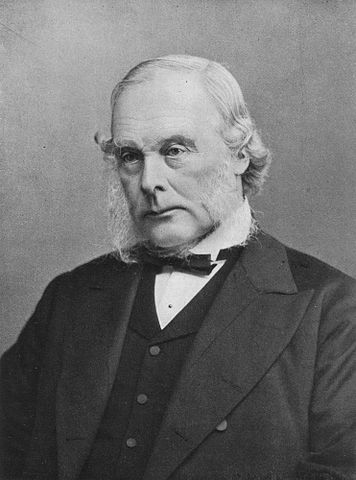
Joseph Lister was born in Britian in 1827. He became a doctor in 1950 and a surgeon shortly after. During his career he revolutionized the way surgery was performed, saved countless lives, and made surgery safer for all of us today. He realized that germs were responsible for the majority of deaths after surgery and he came up with ways to fight them.
In the millennia from the first surgical operation up to the time of Lister, surgery has always been a very big risk. Even today, it is a risk, but that risk is much lower than it used to be. Many patients that underwent surgery died of infection or gangrene after the surgery was completed. People would avoid surgery if it was at all possible. These statistics are illustrated rather well by the American Civil War from 1861 to 1865. Approximately 660,000 soldiers were killed in the war and 440,000 of those were killed by infections that developed after they had been removed from the battlefield and been operated on. This was a trend that existed in all hospitals in peacetime as well. There was very little sanitation. Doctors and surgeons did not wash their hands or change their clothes between operations. Utensils were not sterilized and operating rooms were not thoroughly cleaned. Surgeons in Lister’s time talked of a “good old surgical stink”.
Lister became a surgeon and moved to Edinburgh, Scotland. While he was there, he started to study inflammation. He had several high powered microscopes and he began to study tissue samples with them. He is probably the first person to study tissue samples with a microscope and this method alone did a lot to advance medical science. Other surgeons and hospitals began to use the same methods. Lister was fortunate because his father was Joseph Jackson Lister, a physicist and opticist who was greatly interested in the development of the microscope. In the 1820s and 1830s he made several improvements to the microscopes that existed, improving their magnifying strength. This interest was passed to his son who received several of these magnifying glasses as gifts that he would go on to use for his research.
Lister knew that inflation was a big problem after an operation. It would appear in the wound, the patient would develop a fever, and quite often it would continue to worsen until the patient died. The infection is caused by the body’s response to bacteria, but Lister had no way to know that.
Before Lister started to use sterilization, people believed that a lot of diseases and the infections that killed people after surgery were caused by something they called miasma. This was thought to be bad air full of particles that came off dead bodies or rotting things. Hospital windows were occasionally opened to let this miasma out and people thought this was the reason why so many poor people living in close together houses became sick. If one of them breathed in the miasma, then they all would.
Lister moved to Glasgow to continue his hospital work and he also continued his research at the same time into infection. While he was there, he heard about Louis Pasteur’s research into fermentation and putrefaction. Pasteur had discovered that there were living things that caused things to ferment or putrefy. Pasteur showed that these living things could travel through the air or on surfaces. He showed that they could be cultivated. Many people didn’t agree with Pasteur, but Lister’s brilliance is that he instantly saw this as the reason for the infections after surgery. Our skins keep us protected from bacteria, but when we undergo surgery, the skin is cut and bacteria can get into the open wound. Lister didn’t know what bacteria were, but he understood that he needed to find a way to keep the wound clean.
Lister realized that the infections were being caused by these living things on the skin, on the surgeon’s hands, on the clothes, on the surgical instruments, and in so many other places. He decided to experiment. He tried a few substances, but they didn’t work. In 1865, he covered a patient’s wound with lint dipped in carbolic acid solution, then applied a dressing with a putty made from carbolic acid. The dressing was regularly changed, and the patient’s wound healed with no infection. Lister knew that he was on to something. He didn’t know that the carbolic acid destroys the cell membranes of the bacteria, killing them. He tried this on more people throughout 1865 and 66. There was no doubting his carbolic method because patients who would normally have died, lived, and the mortality rate dropped. He knew he had to share this information and in 1867 he published “On a New Method of treating Compound Fracture, Abscess, Etc with Observations on the Conditions of Suppuration.”
The result of Lister’s publication was … criticism. Nobody believed him. He gave speeches, refined his technique, created new techniques, and published research, but people wouldn’t believe him because the germs were too small to be seen. He didn’t give up, and his ideas were slowly taken up, although not in his native Britain. German was the first country to take up Lister’s sterilization and antiseptic method. Then the United States and France followed suit. Britain was actually the last country to take it up. Lives were lost because of this closed-mindedness. However, in the long run, Lister’s discoveries have had a huge impact and mean that most of us don’t die from a broken leg. And this is what I learned today.
Image By Unknown author – Weltrundschau zu Reclams Universum 1902, Public Domain, https://commons.wikimedia.org/w/index.php?curid=9647607
Sources
https://pubmed.ncbi.nlm.nih.gov/8513069/
https://www.hopkinsmedicine.org/health/conditions-and-diseases/gangrene
https://en.wikipedia.org/wiki/Joseph_Jackson_Lister
https://en.wikipedia.org/wiki/Joseph_Lister
https://www.ncbi.nlm.nih.gov/pmc/articles/PMC3468637/
https://www.ncbi.nlm.nih.gov/pmc/articles/PMC1121911/
https://en.wikipedia.org/wiki/Miasma_theory
https://academic.oup.com/book/40708/chapter-abstract/348450492?redirectedFrom=fulltext
